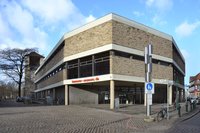Zweisitziges Hanomag 2/10 PS Cabriolet. Der grün lackierte Wagen mit Klappverdeck hat das Steuer auf der rechten Seite.
Wegen seiner runden Form wurde der „kleine Hanomag“ im Volksmund „Kommissbrot" genannt. Der preisgünstige Kleinwagen konnte bis zu 60 km/h fahren und verbrauchte ca. 4 Liter Kraftstoff auf 100 km. „3 Kilo Blech, ein Kilo Lack – fertig ist der Hanomag“ – dieser despektierliche Spruch bezieht sich auf die einfache Konstruktion des Wagens, der auch als Limousine und sogar als Lieferwagen erhältlich war.
Ab 1925 wurde das Auto als erster PKW in Deutschland in Fließbandfertigung bei Hanomag in Hannover hergestellt. Bis 1928 wurden insgesamt 15.775 „Kommissbrote“ produziert. Drei davon sind im Besitz des Historischen Museums Hannover, eines davon ist fahrbereit.
[FA]
en

